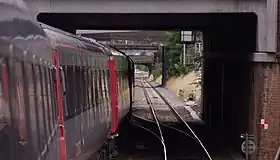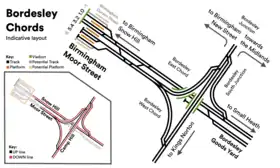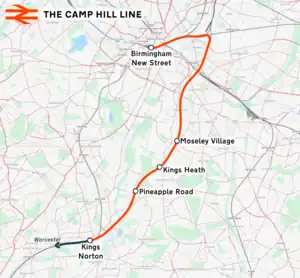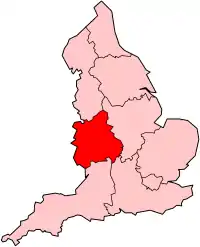Camp Hill line
The Camp Hill line is a railway line in Birmingham between Kings Norton on the Cross-City Line and Birmingham New Street via Grand Junction on the main lines from Derby and Coventry. The line was once the terminal approach of the Birmingham and Gloucester Railway to Curzon Street before it was incorporated into the Midland Railway.
| Camp Hill line | |||
|---|---|---|---|
 A non-stop CrossCountry passenger service powers along the Camp Hill line to bypass the University branch  A 1913 map showing the Birmingham West Suburban Railway (left) and the Camp Hill line (right) between Kings Norton and Birmingham New Street | |||
| Overview | |||
| Status | Operational | ||
| Owner | Network Rail | ||
| Locale | Birmingham | ||
| Termini | |||
| Service | |||
| Type | Heavy rail | ||
| System | National Rail | ||
| Operator(s) | CrossCountry West Midlands Trains | ||
| Rolling stock | Class 170 "Turbostar" Class 172 "Turbostar" Class 220 "Voyager" Class 221 "Super Voyager" | ||
| History | |||
| Opened | 1840-41 | ||
| Technical | |||
| Number of tracks | 2 | ||
| Track gauge | 4 ft 8+1⁄2 in (1,435 mm) standard gauge | ||
| |||

Camp Hill line | |||||||||||||||||||||||||||||||||||||||||||||||||||||||||||||||||||||||||||||||||||||||||||||||||||||||||||||||||||||||||||||||||||||||||||||||||||||||||||||||||||||||||||||||||||||||||||||||||||||||||||
|---|---|---|---|---|---|---|---|---|---|---|---|---|---|---|---|---|---|---|---|---|---|---|---|---|---|---|---|---|---|---|---|---|---|---|---|---|---|---|---|---|---|---|---|---|---|---|---|---|---|---|---|---|---|---|---|---|---|---|---|---|---|---|---|---|---|---|---|---|---|---|---|---|---|---|---|---|---|---|---|---|---|---|---|---|---|---|---|---|---|---|---|---|---|---|---|---|---|---|---|---|---|---|---|---|---|---|---|---|---|---|---|---|---|---|---|---|---|---|---|---|---|---|---|---|---|---|---|---|---|---|---|---|---|---|---|---|---|---|---|---|---|---|---|---|---|---|---|---|---|---|---|---|---|---|---|---|---|---|---|---|---|---|---|---|---|---|---|---|---|---|---|---|---|---|---|---|---|---|---|---|---|---|---|---|---|---|---|---|---|---|---|---|---|---|---|---|---|---|---|---|---|---|---|
| |||||||||||||||||||||||||||||||||||||||||||||||||||||||||||||||||||||||||||||||||||||||||||||||||||||||||||||||||||||||||||||||||||||||||||||||||||||||||||||||||||||||||||||||||||||||||||||||||||||||||||
The expansion of the Birmingham West Suburban Railway resulted in its usurping of the line as the service's main line, at which point it became known as the Camp Hill line after its original terminus. Local passenger services on the line ended in the 1940s and the intermediate stations on the line were closed. Since then it has been used primarily by freight trains and some longer-distance passenger trains only.
It is hoped to resume local services on the route by the end of 2024 after a break of nearly 84 years. Expansion of these services via new chords connecting the line to Birmingham Moor Street are currently in the early planning stage.
History
It opened as the northernmost stretch of the B&GR main line which in December 1840 and ran from Gloucester to a temporary terminus at Camp Hill. The line was extended into Curzon Street – the main station in Birmingham at that time – in August the following year; with the original Camp Hill terminus being split into a smaller passenger station and a goods station, the latter of which remained open until 1966. The B&GR itself was incorporated into the Midland Railway in 1845.[1] The terminus then later switched from Curzon Street to Birmingham New Street station upon its opening in 1854.[2]
In 1861 a junction was constructed at Bordesley, creating a north to south-east connection from the Camp Hill line to the Great Western Railway's mainline to Oxford and London (which remains in use as the Chiltern Main Line), and allows trains from Oxford and beyond to run into Birmingham New Street via the Camp Hill line.[3]
In 1864 a 'direct' line was opened between St Andrews and Landor Street Junctions at the north end of the Camp Hill line, connecting it to the Midland Railway's line to Derby. From this date Midland expresses from Derby to Bristol by-passed New Street, and ran via this route to Camp Hill station, where portions of the train bound for Birmingham New Street would be detached or attached from the train. As both the Midland Railway lines from Derby and Bristol approached New Street from the east, this arrangement avoided the need for them to reverse at New Street and thus save time. This arrangement was unsatisfactory, but it persisted until 1885 when the Midland Railway extended the BWSR into New Street from the west, allowing Derby to Bristol trains to run directly through New Street without reversing and rejoin the B&GR route at Kings Norton railway station.[4] With the BWSR in effect replacing the former B&GR mainline as the express route to Birmingham New Street, the route became known as the Camp Hill line.
In 1892, the Lifford Curve opened, creating a north-facing connection between the Camp Hill line and the Birmingham West Suburban Railway, allowing a circular service to operate from New Street via the Camp Hill line and returning via the BWSR (or vice versa). Local passenger services and all six passenger stations along the Camp Hill line were closed as a wartime rationalisation of the network in 1941 and were confirmed as permanently closed in 1946. All station buildings were subsequently demolished.
Since then the line has been used by freight trains and some longer distance passenger trains only.[4]
Reinstatement of passenger services
The reinstatement of local rail services to the former Camp Hill line has been a long term aspiration of the city,[5] and during 2007, Birmingham City Council announced that they were looking into the possibility of reopening the line between Kings Norton and Birmingham Moor Street via the construction of a railway viaduct from Sparkbrook to Bordesley, where trains would be taken into Birmingham Moor Street station. In October 2007, a 1,500-name petition was handed in to the council asking for the line to be re-opened.[6] In 2013 the proposal was shelved indefinitely.[7] The 2007 proposed station sites were Moseley, Kings Heath, and Hazelwell.
In 2016, the newly created West Midlands Combined Authority revived the plans to restore local passenger services to the line, and declared it one of their priority transport schemes to be delivered by 2025.[8][9]
In 2017, the newly elected Mayor of the West Midlands Andy Street pledged to get work started on restoring services to the line by 2020. Officials were said to be investigating the business case for a fourth station at Balsall Heath (previously called Brighton Road).[10] This would mean Lifford and Camp Hill would be the only stations not to be reopened.
In August 2017, West Midlands Trains announced plans as part of their franchise deal that the line would reopen by December 2019 as part of a £1 billion investment in the West Midlands. This included a new station at Moseley.[11]
In February 2018, Mayor of the West Midlands, Andy Street, said that the viaduct would not immediately be needed to open the line. Hereford to Birmingham New Street trains – currently routed via University Station – would be diverted along the Camp Hill line to serve the three new stations, meaning that extra capacity at Birmingham New Street would not be required.[12] This would also facilitate through train operation toward Shrewsbury.
In September 2018, the designs of the new stations – Kings Heath, Pineapple Road, and Moseley Village – were revealed and were planned for reopening by 2021 with a frequency of two trains per hour.[13] In March 2021 it was announced that funding had been found for the project, with an opening date expected in 2023.[14] In June 2022, West Midlands Rail Executive announced that following on from a public consultation, the three stations would be named Moseley Village, Kings Heath and Pineapple Road.[15] An investigation into the business case for reopening Brighton Road as Balsall Heath railway station has since been awarded funding.
This line was identified by Campaign for Better Transport in 2019 as a priority 1 candidate for reopening.[16]
The reopening has been hit by delays and the West Midlands Combined Authority is now aiming to reopen the line for passenger use by the end of 2024.[17][18]
Bordesley Chords


In July 2018 the Midlands Rail Hub proposal was unveiled, which included the reopening of Moseley, Kings Heath, and Hazelwell stations, and the building of set of chords (short connecting curves of track) on new viaducts near Bordesley station known as the Bordesley Chords.
Although the new Camp Hill line services will initially run on existing track into New Street, the long-term aim is to divert them into Moor Street via their construction. Currently the Camp Hill line – already extensively connected to the Cross-City Line, Cross Country Route, and WCML – passes over the Chiltern Main Line, and they are only connected by a junction to the east of the crossing. The new chords would be constructed to the north and west of the crossing, known as the 'East Chord' and 'West Chord' respectively, connecting Moor Street to Kings Norton to the southwest and Water Orton to the northeast.[19] The chords would also allow a number of services from East Midlands destinations, such as Derby and Leicester, to be diverted into Moor Street.
In conjunction with the construction of the chords, one of the currently derelict terminus platforms at Moor Street would be reopened (Platform 5) and a new through platform to Snow Hill constructed (Platform 0) in order to accommodate the new services. There is also the potential for the other derelict terminus platform (Platform 6) to be reopened and another through platform (Platform −1) added depending on funding and engineering limitations.
Furthermore, construction of the chords would necessitate the closure and demolition of the semi-operational Bordesley station.[20] There is an option to relocate Bordesley station either east or west of its current location as part of the chords' construction.[21] Rerouting of the up/down Snow Hill lines between Moor Street and the chords would also be required.
References
- Christiansen 1983, p. 56.
- Christiansen 1983, p. 55.
- "Bordesley Junction - Exchange Branch". Warwickshire Railways. Retrieved 14 January 2018.
- Christiansen 1983, pp. 59–61.
- "Reinstatement of Camp Hill Rail Services Moves A Step Closer". Birmingham City Council. 13 July 2007. Archived from the original on 11 January 2008. Retrieved 4 February 2008.
- "Camp Hill railway petition delivered". Birmingham Post. 11 October 2007. Retrieved 4 February 2008.
- Gabriel, Keith (21 June 2013). "Council shunt Moseley and Kings Heath railway stations into the sidings". Birminghampost.co.uk. Retrieved 10 March 2022.
- "Could Moseley to Birmingham trains return to end commuter hell?". Birmingham Mail. 9 June 2016. Retrieved 20 July 2016.
- "£4Bn West Midlands transport boost unveiled by council leaders". The Chamberlain Files. 15 June 2016. Retrieved 20 July 2016.
- "This Birmingham train station is set for a revival". Birmingham Mail. 6 July 2017. Retrieved 6 July 2017.
- "West Midlands: London Midland loses its rail franchise (Aug 2017)". Retrieved 10 March 2022 – via YouTube.
- "These city train stations could re-open sooner than we thought". Birminghammail.co.uk. 28 February 2018.
- "Future for new Birmingham railway stations revealed in new images". Birminghampost.co.uk. 26 September 2018.
- "Full steam ahead for Camp Hill line to reopen as final budget approved". West Midlands Combined Authority. Retrieved 20 August 2021.
- "New Birmingham railway station names announced following public consultation". wmre.org.uk. Retrieved 1 November 2022.
- "The case for expanding the rail network" (PDF). Bettertransport.org.uk. January 2019. Archived (PDF) from the original on 22 April 2019. Retrieved 10 March 2022.
- "Camp Hill: Further delays to south Birmingham railway line". BBC News. 27 June 2023. Archived from the original on 27 June 2023. Retrieved 28 June 2023.
- "Birmingham stations project hit by year-long delays". The Construction Index. 28 June 2023. Archived from the original on 28 June 2023. Retrieved 29 June 2023.
- "Archived copy" (PDF). Archived from the original (PDF) on 10 July 2018. Retrieved 10 July 2018.
{{cite web}}: CS1 maint: archived copy as title (link) - "£2 billion Midlands Rail Hub plans set out". Modern Railways. 25 July 2019. Retrieved 1 April 2023.
- "More trains an hour through Birmingham Moor Street as part of £2 billion Midlands rail upgrade plans". Birmingham Updates. 26 June 2019. Retrieved 1 April 2023.
Bibliography
- Christiansen, Rex (1983). A Regional History of the Railways of Great Britain, Volume 7 The West Midlands. David St John Thomas David & Charles. ISBN 0-946537-00-3.
- Boynton, John (1993). Rails Across The City, The Story of The Birmingham Cross City Line. Kidderminster: Mid England Books. ISBN 0-9522248-0-1.
External links
- Birmingham City Council Camp Hill Railway Line Study Public Report, July 2007
- Birmingham City Council Detailed map of the proposed railway chord linking the Camp Hill line into Moor Street Station

